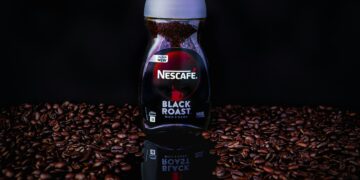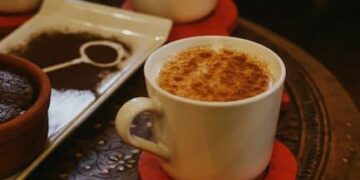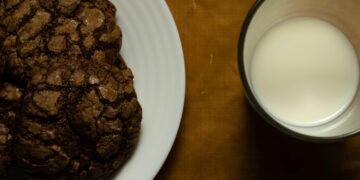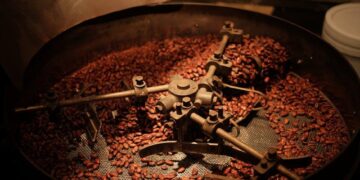Table of Contents
Part I: The Collapse – My Quest for the Perfect, Unattainable Foam
A. Introduction: The Day the Foam Broke My Heart
My name is Alex, and for the better part of a decade, I’ve dedicated my life to understanding the science behind the food we love.
As a food scientist and passionate home cook, I believed that with enough precision and the right recipe, anything was possible.
Then, I tried to make salted caramel cold foam.
It was for a small family brunch, a simple gathering I wanted to make special.
I envisioned it perfectly: tall glasses of smooth, dark cold brew crowned with a thick, velvety blanket of sweet and salty foam, cascading gently into the coffee below.
I had researched dozens of popular recipes.
I bought the expensive heavy cream, the artisanal caramel syrup, and the flaky sea salt.
I followed the instructions to the letter.
What I served was a tragedy in a glass.
Instead of a luscious, stable crown, I had a thin, bubbly slick that dissolved into the coffee almost instantly.
What remained was a runny, overly salty, and disappointingly separated liquid that made the entire drink taste… wrong.
It was more than just embarrassing; it was a professional affront.
It was a failure that set me on a quest.
I had to understand why this seemingly simple concoction was so prone to catastrophic, inconsistent failure.
If you’ve ever felt this frustration—if you’ve followed a recipe meticulously only to be met with a runny, bubbly mess—you are not alone.
This maddening inconsistency is a well-documented problem, lamented by home baristas and even seasoned professionals in coffee shops worldwide.1
But I’m here to tell you that it’s not your fault.
You haven’t been failing the recipe; the recipe has been failing you.
You’ve been given the wrong map for a journey that requires not a simple blueprint, but a deep understanding of architecture.
B. The Blueprint Trap: Why Every Recipe is a Gamble
In the aftermath of my foam fiasco, I did what any scientist would do: I treated it as a failed experiment and analyzed the variables.
I quickly realized that a standard recipe—a list of ingredients and a few lines of instruction—is a static blueprint for an incredibly dynamic process.
It’s a gamble because it fails to account for the hidden variables that can doom your foam from the very start.
First is the profound variability of the ingredients themselves.
A recipe might call for “heavy cream,” but the precise fat percentage can fluctuate between brands and even between cartons.3
The freshness of your milk is another critical factor; milk that has been in the fridge for several days simply doesn’t froth as well as fresh milk, a detail no recipe ever mentions.4
The very nature of your caramel is another trap.
A thick, viscous caramel
sauce will behave differently in the liquid than a thin, pourable caramel syrup, altering the density and the energy required to create a stable foam.4
Temperature is another silent assassin of foam.
Baristas know from hard-won experience that sweet cream must be kept exceptionally cold to foam properly.
A pitcher left on the counter for even a short period can warm up just enough to refuse to whip into a thick consistency.1
But the most insidious variable, the one that explained the sheer randomness of my failures, was revealed in a forum discussion among baristas.
One insightful professional pointed out that the standard “sweet cream” mixture—a combination of high-fat heavy cream and low-fat 2% milk—is not a stable solution.
Over time, even in the fridge, it separates.
The less-dense fat from the heavy cream naturally rises to the top.5
This single observation was a revelation.
It meant that a person pouring from the top of a freshly made but settled pitcher would get a scoop of high-fat, beautifully thick foam.
The next person, pouring from the lower part of that same pitcher, would get a watery, low-fat liquid that could never create a stable structure.
They were using the same “recipe,” but building with entirely different materials.
This is the blueprint trap.
It gives you a list of parts but tells you nothing about how to handle them, how they interact, or the fundamental physics that govern their assembly.
To succeed, I needed to throw out the blueprint and learn how to be an architect.
Part II: The Epiphany – It’s Not a Recipe, It’s Architecture
A. From the Kitchen to the Drafting Table
My journey took me away from recipe blogs and into the world of culinary chemistry.
I started reading textbooks on food structure, colloid science, and the physics of emulsions.
The “aha!” moment didn’t come from a coffee forum, but from a chapter on sauce making.
I realized I had been approaching foam like a baker following a cake recipe, where a little extra flour or a slightly different oven temperature might result in a minor imperfection.
This was wrong.
Perfect foam isn’t baked; it’s built.
It’s a feat of structural engineering in miniature.
A building requires an intimate knowledge of its materials, the physical laws that govern its stability, and the precise techniques needed to assemble it.
A weak foundation or poor construction methods will lead to collapse, every time.
I had to stop being a line cook and start being a Foam Architect.
B. The Science of Structure: Vinaigrette vs. Mayonnaise
To understand the architectural challenge, we need to look at two of the most common sauces in any kitchen: vinaigrette and mayonnaise.
Both are emulsions—a mixture of two liquids that don’t naturally combine, like oil and water.6
But they represent two vastly different structural outcomes.
A simple vinaigrette is a temporary emulsion.
You can combine oil and vinegar in a jar and shake it vigorously.
The agitation breaks the oil into tiny droplets that disperse through the vinegar, creating a unified dressing.8
But it is inherently unstable.
Left to sit for even a few minutes, the oil droplets will find each other, merge, and separate back into a distinct layer.
This was my failed foam: a temporary structure that looked passable for a moment before collapsing into its constituent parts.
Mayonnaise, on the other hand, is a permanent emulsion.
It combines oil with a water-based ingredient (like lemon juice or vinegar) and an egg yolk.
The magic is in the egg yolk, which contains a powerful emulsifying agent called lecithin.8
When the oil is slowly whisked into the yolk, the lecithin molecules wrap around each tiny oil droplet, creating a protective barrier that prevents them from rejoining.
This process creates a thick, creamy, and remarkably stable structure that can last for weeks.8
This was the structure I needed to build.
This analogy reframed the entire problem.
My goal was no longer to just “mix” ingredients.
My goal was to construct a foam with the structural integrity of mayonnaise, not the fleeting unity of a vinaigrette.
Cold foam is an even more complex system—it’s a gas (air) suspended within a liquid oil-in-water emulsion.
To achieve that mayonnaise-like stability, I had to master the architectural principles governing its creation.
I had to become the architect of my own foam.
Part III: The Four Pillars of Foam Architecture
This new paradigm is built on four foundational pillars.
Master these, and you move beyond the gamble of a recipe into the realm of consistent, repeatable success.
You become the architect, capable of designing and constructing a perfect foam structure every single time.
Pillar 1: The Foundation – Mastering Your Building Materials (The Ingredients)
An architect would never design a skyscraper without an exhaustive understanding of the properties of steel, concrete, and glass.
Likewise, a Foam Architect must know the precise structural role of each ingredient.
The Dairy Trinity: The Core Structural Components
The base of our foam is a carefully balanced mix of dairy, primarily heavy cream and 2% milk.
They are not interchangeable; each serves a distinct architectural purpose.
- Heavy Cream: The Source of Richness and Texture. The primary contribution of heavy cream is its high fat content (butterfat). These fat globules are responsible for the luxurious, creamy mouthfeel and the velvety texture of a perfect foam.11 Think of this as the plush carpeting and fine marble of our building—it provides the richness and sensory experience.
- 2% Milk: The Source of Protein and Structure. The 2% milk is the structural steel of our foam. Its most important contribution is its higher relative concentration of proteins (whey and casein) and water.11 As we’ll see in Pillar 2, these proteins are the emulsifiers that form the very scaffold of the foam structure. While whole milk might seem like a richer choice, its higher fat content can actually be detrimental to the stability of
cold foam, making it a riskier building material.14 - The Golden Ratio: A thorough analysis of dozens of successful copycat recipes and barista guides reveals a clear pattern. The most stable and texturally pleasing foams adhere to a specific range of ratios, typically between 2:1 and 3:2 of heavy cream to 2% milk.16 This isn’t an arbitrary measurement; it’s a calculated balance. It provides enough protein from the milk to build a robust scaffold, while incorporating enough fat from the cream for a luxurious texture, without overwhelming the system.
The Flavor Engine: Caramel Syrup vs. Sauce
The choice between caramel syrup and caramel sauce is not merely about flavor; it’s a decision about viscosity and density.
A thin, pourable syrup (like those made for coffee) will integrate easily into the dairy base.
A thick, gooey dessert sauce, however, will increase the overall density of the mixture, requiring more energy to froth and potentially altering the final bubble structure.4
For consistency, a liquid coffee syrup is the more reliable choice.
The Keystone: Salt
Salt is the keystone of our arch—a small element that locks the entire structure together.
Its primary role is flavor, cutting through the sweetness of the caramel and the richness of the cream to create a more complex, “grown-up” taste.
However, its role may be more than just sensory.
In food science, particularly in cheesemaking, salt concentration is known to influence how proteins behave and coagulate.19
While its effect in cold foam is more subtle, it plays a crucial role in the overall balance.
Be warned: the foam itself is designed to be intensely flavored and is often too salty to be enjoyed on its own.
Its flavor is meant to be balanced by the unsweetened, bitter coffee it tops.21
A fine sea salt is recommended as it dissolves more easily than coarse salt.21
To translate this material science into practical application, here is a guide to how adjusting the foundational dairy ratio impacts the final structure:
| Table 1: The Architect’s Material Mix (Dairy Ratios & Outcomes) | |||
| Ratio (Cream:Milk) | Resulting Texture | Stability | Best Use Case |
| 3 parts cream : 1 part milk | Very dense, rich, spoonable | Highest stability | A decadent, dessert-like topping that sits high on the coffee. |
| 3 parts cream : 2 parts milk | Creamy yet easily pourable | High stability | The “coffee shop standard.” The perfect all-purpose balance of texture and flow. |
| 1 part cream : 1 part milk | Lighter, more airy, delicate | Moderate stability | A less rich experience where the foam melts into the drink more quickly. |
Pillar 2: Structural Engineering – The Unseen Physics of Foam (The Science)
This pillar is the physics lesson every architect needs.
It explains the unseen forces at play, turning abstract rules like “use cold milk” into concrete scientific principles.
Understanding this science is the difference between hoping for a good result and engineering one.
Protein Scaffolding: The Power of Denaturation
When you froth milk, you are doing far more than just “adding air.” The intense mechanical force from a blender or frother is a process known as protein denaturation.19
Milk contains two primary types of proteins: whey and casein.13
In their natural state, these proteins are folded up into complex, compact balls, like tiny balls of yarn.11
The vigorous agitation forces these proteins to unravel and unfold, stretching them out into long strands.24
Once unfolded, these strands expose reactive parts that were previously hidden.
They begin to link up with other unfolded protein strands, forming an intricate, cross-linked mesh.
This protein mesh is the architectural scaffolding of your foam.
It creates millions of tiny pockets that trap the air bubbles you’ve introduced, holding them in place and giving the foam its structure and volume.11
Without this denaturation and subsequent linking (coagulation), the air bubbles would simply escape, and the liquid would remain flat.
The Fat Paradox: A Friend and Foe
Here we arrive at one of the most critical and counterintuitive principles of cold foam architecture.
Fat is essential for the creamy taste and texture, but it is also the single greatest threat to the foam’s stability.
This is the Fat Paradox.
In hot-frothed milk (like for a latte), the fat globules melt into a liquid state and peacefully coexist within the protein scaffold.
But in cold foam, which is prepared at temperatures well below 40°C (104°F), the milk fat globules remain in a partially crystallized, solid state.14
These tiny, hard crystals are brittle and fragile.
If the frothing process is too aggressive, or if the protein scaffold is not strong enough to protect them, these crystallized fat globules can rupture.
When they break, they release liquid fat (lipids) that spreads across the surface of the protein scaffold and the air bubbles.
This lipid coating destabilizes the structure, causing the air bubbles to merge and collapse in a process called coalescence.14
Think of these fragile fat crystals as tiny wrecking balls embedded in your structure.
If you’re not careful, they will bring the whole thing down.
This paradox scientifically explains why the dairy ratio from Pillar 1 is so important.
You need enough fat from the heavy cream for texture, but not so much that you introduce an unmanageable number of “wrecking balls.” It also explains why whole milk, with its higher fat-to-protein ratio compared to 2%, is often a poor choice for building stable cold foam.
Climate Control: The Non-Negotiable Role of Temperature
Given the fragility of cold fat globules, temperature control is not a suggestion; it is an absolute structural requirement.
Every ingredient and every tool—the milk, the cream, the frothing vessel, the whisk—must be thoroughly chilled before you begin.1
Cold temperatures serve two critical engineering functions:
- They stabilize the fat: Keeping the temperature low ensures the fat globules remain in their solid, crystalline state and are less likely to rupture during the frothing process.14
- They increase viscosity: Colder liquids are thicker. This increased viscosity helps in the formation of smaller, more uniform, and more stable air bubbles during frothing, leading to a finer, creamier foam.
Understanding the science of this pillar illuminates the rules of the first.
The “Golden Ratio” of dairy works because it optimizes the protein-to-fat balance, creating a strong enough scaffold to contain the fat required for texture.
The mandate for cold is a direct response to the Fat Paradox, a necessary precaution to keep the “wrecking balls” from demolishing your carefully constructed foam.
Pillar 3: The Construction Site – From Blueprint to Reality (The Technique)
An architect can have the finest materials and a perfect grasp of physics, but without skilled builders and the right equipment, the structure will never be realized.
This pillar covers the “how-to”—the construction methods that bring your foam to life.
Choosing Your Heavy Machinery: A Guide to Frothing Tools
The tool you use to froth your foam has a dramatic impact on the final texture and consistency.
Each has its own strengths and weaknesses.
- High-Powered Blender: This is the industrial crane of foam making. The high shear force creates the smallest, most uniform bubbles, resulting in the thickest, creamiest, and most stable foam. This is the gold standard for replicating the dense texture of coffee-shop foam.21
- Handheld Milk Frother: This is the versatile power tool found in most home kitchens. It’s fast, convenient, and highly effective. However, technique matters. Holding the frother too close to the surface can incorporate large, unstable bubbles. For best results, keep the whisk fully submerged to create a vortex that shears the liquid into a fine micro-foam.16
- French Press: This is the clever, hand-cranked winch. Many people don’t realize that a French press is an excellent foaming tool. By pouring the ingredients into the carafe and pumping the plunger vigorously up and down, you force air through the liquid, creating a surprisingly dense and creamy foam.29
- Mason Jar: This is the pure manual labor option. It requires sealing the ingredients in a jar and shaking vigorously for 1-2 minutes. While it works in a pinch, it’s difficult to achieve the same level of uniformity and stability as with mechanical tools.28
The Golden Window: Mastering Frothing Duration
The amount of time you spend frothing is a critical variable.
Across numerous recipes and guides, a “golden window” emerges: 30 to 60 seconds for most mechanical methods.15
- Under-mixing: Frothing for too little time fails to sufficiently denature the proteins. The scaffold will be weak, and the foam will be thin and runny.
- Over-mixing: Pushing past the golden window can have two negative effects. It can begin to turn the mixture into full-fledged whipped cream, making it too thick to pour properly. In some cases, the prolonged, aggressive agitation can generate just enough friction and energy to rupture the fragile cold fat globules, causing the foam to break and collapse.
The Architect’s Method: A Step-by-Step Master Guide
This is the definitive construction sequence, integrating the principles from all pillars.
- Site Prep: Chill all your tools. Place your frothing vessel (blender cup, glass, French press) in the freezer for 5-10 minutes before starting.
- Gather Materials: Ensure your heavy cream, milk, and caramel syrup are cold, directly from the refrigerator.
- Measure Precisely: Using a measuring spoon, measure your chosen ratio of dairy and syrup directly into the chilled frothing vessel. Add a pinch of fine sea salt.
- Re-emulsify (Crucial for Batches): If you are using a pre-mixed batch of sweet cream, always whisk or shake the container vigorously before pouring your serving. This redistributes the separated fat and ensures you are working with the correct ratio of materials.5
- Construct: Froth the mixture using your chosen tool, aiming for the 30-60 second golden window. Watch for the signs: the volume should nearly double, and the texture should become thick, glossy, and pourable, like melted ice cream.
- Pour Immediately: Gently pour or spoon the finished foam over your iced cold brew. A well-constructed foam will sit majestically on top before slowly cascading into the drink.
To help you select the right construction method for your needs, consult the following table.
| Table 2: Construction Method vs. Foam Quality | ||||
| Method | Speed | Resulting Foam Quality | Stability | Best For |
| High-Powered Blender | Fast (30-45 sec) | Thick, dense, uniform micro-foam | Very High | Achieving the exact coffee-shop texture. |
| Handheld Frother | Very Fast (30-60 sec) | Creamy, can have slightly larger bubbles | High | Quick, convenient, single-serving foams. |
| French Press | Moderate (60-90 sec) | Dense, creamy, fine-textured foam | High | Excellent results for those without a blender. |
| Mason Jar | Slow (1-2 min) | Less uniform, frothy, larger bubbles | Moderate | When no other tools are available. |
Pillar 4: Renovations & Custom Builds (Adaptations and Troubleshooting)
The mark of a true architect is not just the ability to follow a plan, but the ability to adapt that plan for different materials and to diagnose and repair structural failures.
This pillar demonstrates how the architectural framework can be applied to create vegan versions and troubleshoot common problems.
The Vegan Blueprint: Engineering a Dairy-Free Foam
Creating a stable dairy-free foam presents a significant architectural challenge.
Plant-based milks lack the specific protein and fat structures of dairy that our entire framework is built upon.4
We cannot simply substitute; we must consciously re-engineer the foundation by sourcing alternative materials that replicate the function of the originals.
- Sourcing the Fat (The Creaminess): The best material to replicate the high-fat content of heavy cream is the hardened cream from a can of full-fat coconut milk. It is essential that the can is thoroughly chilled for at least an hour, which causes the thick cream to solidify and separate from the watery liquid.32 This solid cream is your primary fat source.
- Sourcing the Structure (The Protein): To replicate the structural role of 2% milk, you need a plant-based milk with good foaming properties. The best options are high-quality, creamy oat milk or, even better, a purpose-built “barista blend” plant milk. These barista editions are specifically formulated with added proteins or stabilizers (like gellan gum or phosphates) to improve their ability to denature and form a stable foam scaffold.26
- The Vegan Ratio: The principles remain the same. You need a balanced ratio of your “fat material” (coconut cream) to your “structural material” (barista oat milk). A good starting point is a 2:1 ratio, such as ¼ cup of solid coconut cream to 2 tablespoons of oat milk.32
This process shows the power of the architectural model.
By understanding the function of each ingredient, you can intelligently source alternatives and build a successful structure, even with entirely different materials.
Structural Diagnostics: A Troubleshooting Guide
When your foam fails, don’t despair.
A Foam Architect doesn’t see a disaster; they see a structural problem with a diagnosable cause.
Use this guide to inspect your build.
- Problem: “My foam is runny and thin from the start.”
- Inspection: This is likely a Foundation Failure or a Climate Control Failure.
- Diagnosis:
- Check your dairy ratio. You almost certainly used too much 2% milk and not enough heavy cream, resulting in a weak protein scaffold that cannot support the volume (Pillar 1).3
- Check your temperature. Were your ingredients and tools truly cold? Even a few degrees of warmth can be enough to prevent proper foaming (Pillar 2).1
- Problem: “My foam looks great at first but then quickly separates and gets watery.”
- Inspection: This is a classic Material Handling Failure.
- Diagnosis: If you made a larger batch of sweet cream to store, it has separated in its container. You poured from the watery, low-fat bottom layer. The solution is simple but critical: Always vigorously whisk or shake your sweet cream batch to re-emulsify it right before pouring out a serving (Pillar 1).5
- Problem: “My foam is bubbly and airy, not rich and creamy.”
- Inspection: This is a Construction Method Failure or a Material Mismatch.
- Diagnosis:
- Review your frothing technique. If using a handheld frother, you may have held it too close to the surface, whipping in large, unstable air bubbles instead of creating a vortex for fine micro-foam (Pillar 3).
- Review your materials. Did you use skim milk? Skim milk produces a high volume of foam, but because it lacks fat, the foam is dry, stiff, and composed of large bubbles, not the supple creaminess we are aiming for (Pillar 1).11
Part IV: Conclusion – Becoming the Foam Architect
A. The Structure Stands
A few months after my initial brunch disaster, I hosted another small get-together.
Once again, salted caramel foam cold brew was on the menu.
But this time, I wasn’t a nervous cook following a recipe; I was a confident architect executing a plan.
I chilled my tools.
I measured my cold ingredients using the 3:2 ratio.
I whisked my sweet cream batch before pouring a serving into my blender.
I frothed for precisely 45 seconds.
The result was perfection.
A thick, glossy, stable foam that sat proudly atop the cold brew, with a texture so velvety it was almost unbelievable.
It wasn’t luck.
It was the result of a replicable, understandable system.
The structure stood firm because it was built on a solid foundation of knowledge.
B. Your Architectural License
This journey was never about finding one “perfect” recipe.
It was about discovering a new way of thinking.
The goal was to give you the architect’s toolkit, to empower you to move beyond the frustrating gamble of a faulty blueprint.
By understanding the Four Pillars—The Foundation of your materials, the Structural Engineering of food science, the Construction Methods of technique, and the principles of Renovation and Adaptation—you are no longer at the mercy of chance.
You can diagnose problems, adapt to new ingredients like dairy-free alternatives, and consistently build the perfect foam structure that you envision.
You are no longer just a cook.
You are now the Foam Architect.
Works cited
- Inconsistent Salted Sweet Cream Cold Foam Cold Brew : r/starbucks, accessed August 3, 2025, https://www.reddit.com/r/starbucks/comments/a1bxk1/inconsistent_salted_sweet_cream_cold_foam_cold/
- What causes a CF Carmel cold brew to suck? : r/starbucks – Reddit, accessed August 3, 2025, https://www.reddit.com/r/starbucks/comments/o5n5i0/what_causes_a_cf_carmel_cold_brew_to_suck/
- Why does cold foam consistency vary so much??? : r/starbucksbaristas – Reddit, accessed August 3, 2025, https://www.reddit.com/r/starbucksbaristas/comments/16pc580/why_does_cold_foam_consistency_vary_so_much/
- Salted Caramel Cold Foam – The Littlest Crumb, accessed August 3, 2025, https://thelittlestcrumb.com/salted-caramel-cold-foam/
- Proving why the Vanilla Sweet Cream Cold Foam is inconsistent (WITH SCIENCE!) – Reddit, accessed August 3, 2025, https://www.reddit.com/r/starbucks/comments/lb3wm1/proving_why_the_vanilla_sweet_cream_cold_foam_is/
- Emulsion – Food Literacy Center, accessed August 3, 2025, https://www.foodliteracycenter.org/food-wiki/emulsion
- Fats and oils: emulsification | Institute of Food Science and Technology – IFST, accessed August 3, 2025, https://www.ifst.org/lovefoodlovescience/resources/fats-and-oils-emulsification
- What Is an Emulsion? – The Spruce Eats, accessed August 3, 2025, https://www.thespruceeats.com/what-is-an-emulsion-995655
- Common Culinary Emulsions – Molecular Recipes, accessed August 3, 2025, http://www.molecularrecipes.com/emulsions/common-culinary-emulsions/?no_redirect=true
- The science of the ideal salad dressing | University of Tasmania, accessed August 3, 2025, https://www.utas.edu.au/about/news-and-stories/articles/2024/the-science-of-the-ideal-salad-dressing
- The Facts about Milk Foam | RICARDO, accessed August 3, 2025, https://www.ricardocuisine.com/en/articles/food-chemistry/521-the-facts-about-milk-foam
- The Science of Frothed Milk – CRU Kafe, accessed August 3, 2025, https://www.crukafe.com/blogs/news/the-science-of-frothed-milk
- Why Does Milk Foam & How Does It Affect Your Coffee? – Perfect Daily Grind, accessed August 3, 2025, https://perfectdailygrind.com/2018/12/why-does-milk-foam-how-does-it-affect-your-coffee/
- The Science Behind Cold Foam and Latte Art | Food Chemistry …, accessed August 3, 2025, https://sciencemeetsfood.org/science-behind-cold-foam-latte-art/
- How to Make Vanilla Sweet Cream Cold Foam – Barefoot In The Pines, accessed August 3, 2025, https://barefootinthepines.com/sweet-cream-cold-foam/
- Salted Caramel Cream Cold Brew {Starbucks Copycat} – The Big Man’s World ®, accessed August 3, 2025, https://thebigmansworld.com/salted-caramel-cream-cold-brew/
- Salted Caramel Cream Cold Brew (Starbucks Copycat) – coffeecopycat.com, accessed August 3, 2025, https://coffeecopycat.com/salted-caramel-cream-cold-brew-starbucks-copycat/
- Single serve cold foam recipe. (Former barista) : r/starbucks – Reddit, accessed August 3, 2025, https://www.reddit.com/r/starbucks/comments/py4y1o/single_serve_cold_foam_recipe_former_barista/
- What is Protein Denaturation? Effects on Food and Health – Agriculture Institute, accessed August 3, 2025, https://agriculture.institute/food-chemistry-and-physiology/protein-denaturation-effects-food-health/
- Apart from the cooking of egg white, are there other good examples from everyday life of protein becoming denatured? – Quora, accessed August 3, 2025, https://www.quora.com/Apart-from-the-cooking-of-egg-white-are-there-other-good-examples-from-everyday-life-of-protein-becoming-denatured
- Salted Caramel Cold Foam (5 Ingredients) – Homebody Eats, accessed August 3, 2025, https://homebodyeats.com/salted-caramel-cold-foam/
- Starbucks-Style Salted Caramel Cold Foam – Homebody Eats – YouTube, accessed August 3, 2025, https://www.youtube.com/watch?v=hLbrlqDBep0
- Protein: acid denaturation | Institute of Food Science and Technology – IFST, accessed August 3, 2025, https://www.ifst.org/lovefoodlovescience/resources/protein-acid-denaturation
- 5 Engaging Ways to Teach Protein Denaturation that Get Students Excited – Labster, accessed August 3, 2025, https://www.labster.com/blog/5-engaging-ways-teach-protein-denaturation
- A Tasting of Culinary Science—Denaturation and Coagulation – YouTube, accessed August 3, 2025, https://www.youtube.com/watch?v=KV5i0VkHtR8
- How to Make Cold Foam for Coffee | Recipes & Tips, accessed August 3, 2025, https://www.bonescoffee.com/a/blog/how-to-make-cold-foam-for-coffee
- Sweet Cream Cold Foam Starbucks Copycat – Maritime Glutton, accessed August 3, 2025, https://www.maritimeglutton.com/sweet-cream-cold-foam/
- Starbucks Copycat Salted Caramel Cream Cold Brew Recipe, accessed August 3, 2025, https://munchiesbymallory.com/recipe/starbucks-copycat-salted-caramel-cream/
- Salted Caramel Cream Cold Brew {Starbucks Copycat} – The Girl on Bloor, accessed August 3, 2025, https://thegirlonbloor.com/salted-caramel-cream-cold-brew-starbucks-copycat/
- Salted Caramel Cream Cold Brew – Foxes Love Lemons, accessed August 3, 2025, https://foxeslovelemons.com/salted-caramel-cream-cold-brew/
- Honey Cold Foam Cold Brew Recipe – DripBeans, accessed August 3, 2025, https://dripbeans.com/honey-cold-brew/
- Dairy Free Cold Foam – Chelsea Peachtree, accessed August 3, 2025, https://chelseapeachtree.com/dairy-free-cold-foam/
- Salted Caramel Cold Brew with Coconut Caramel Cold Foam | Natura Market Blog, accessed August 3, 2025, https://naturamarket.ca/blog/salted-caramel-cold-brew-with-coconut-caramel-cold-foam.html
- Vegan Cold Foam – The Simple Sprinkle, accessed August 3, 2025, https://thesimplesprinkle.com/vegan-cold-foam/






